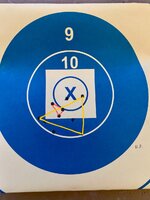Just like before, here is the shot-by-shot breakdown, followed by the tabular breakdown of 2, 3, 4, 5, 10, 20, 30-shot groups
View attachment 500056
View attachment 500057
Median 2-shot group = 0.273 MOA
Median 3-shot group = 0.465 MOA
Median 4-shot group = 0.540 MOA
Median 5-shot group = 0.578 MOA
Median 10-shot group = 0.802 MOA
Median 20-shot group = 0.802 MOA
Median 30-shot group = 0.813 MOA
Overall 34-shot group = 0.8927 MOA
People should be out shooting and figure out what occurs with themselves and their “system”, but below is how my real world groups compare to the statistical scale
View attachment 500058
As should be expected, there is variance when scaling from 2-shot groups, likely due to shooter errors as well as the previously explained suppressor on/off cycles, small differences in environmentals & lighting, etc. The other differences between the tables is quite small from a big picture standpoint. I’ve gone through this exercise again and again, and my experience is that the statistical scale factors are quire close to what I observe shooting in the real world (barrel after barrel and various kinds of factory ammo).
In terms of group zero location, below is a table and some graphs showing the same thing. I broke the graphs out into elevation offset and windage offset since we are bound by our scopes ability to adjust back to zero. The thicker black line shows the respective median elevation and windage location for the overall 34 shot group, the green dash lines are +/-0.1 mil from that 34-shot median location, and then the scatter plot is the zero location of each 3, 4, 5, and 10-shot group.
You can see that all 3-shot groups are within 0.1 mil of the 34-shot group median elevation, with the exception of one group that is right at +0.1 mil. All of the other 4, 5, and 10-shot groups are within 0.1 mil of overall group location, and most are within 0.05 mils of overall group location. Similar results for the windage as well.
View attachment 500059
View attachment 500060
View attachment 500061
Below is a graphic that shows how far the running group count “zero” location is relative to the total 34-shot group location.
View attachment 500062
Again, just sharing data. My real world experience is that statistics is a real thing, 5-shot groups are sufficient for field shooting in terms of zeroing & evaluating mechanical precision, and factory ammo is sufficient to produce 30+ shot sub-moa groups.


